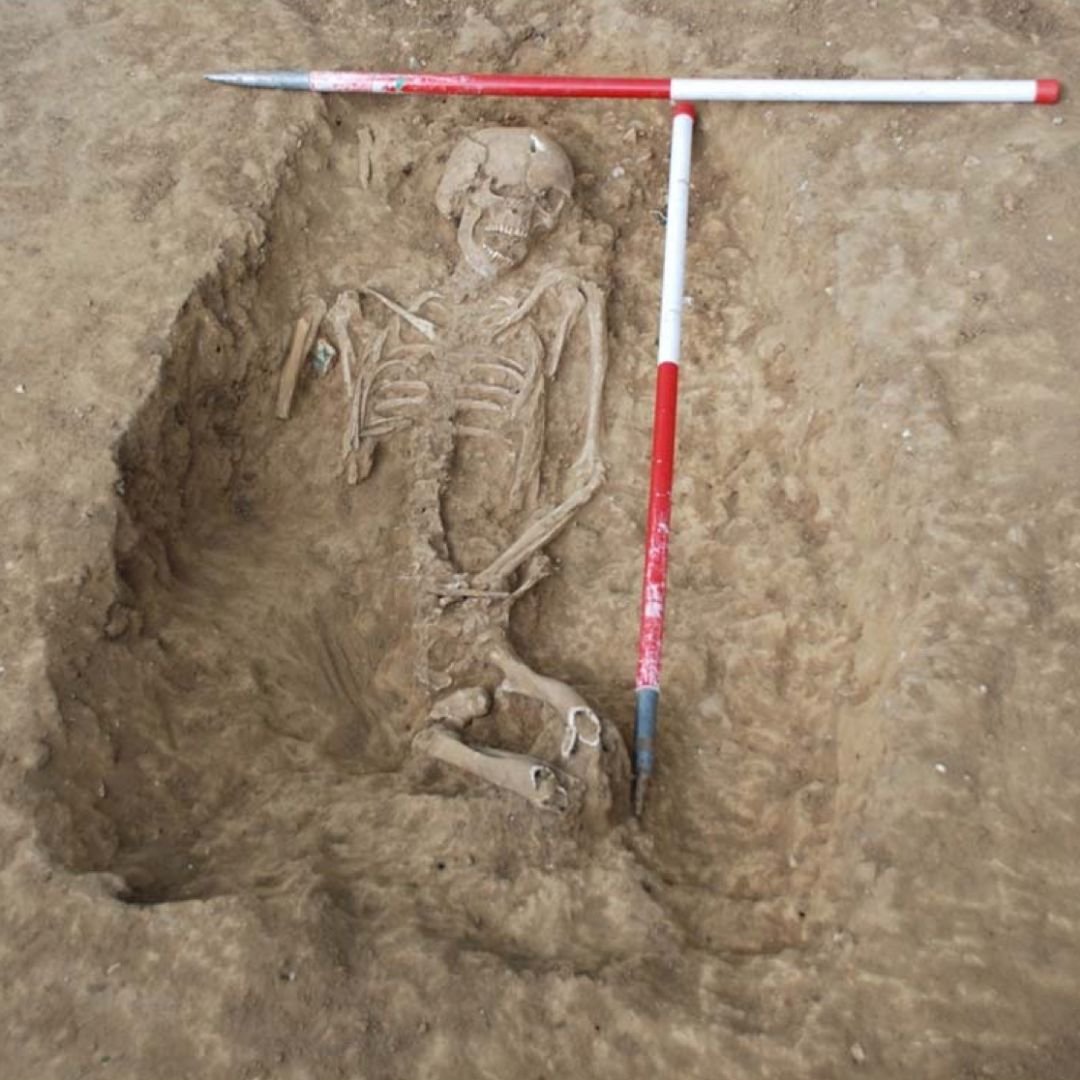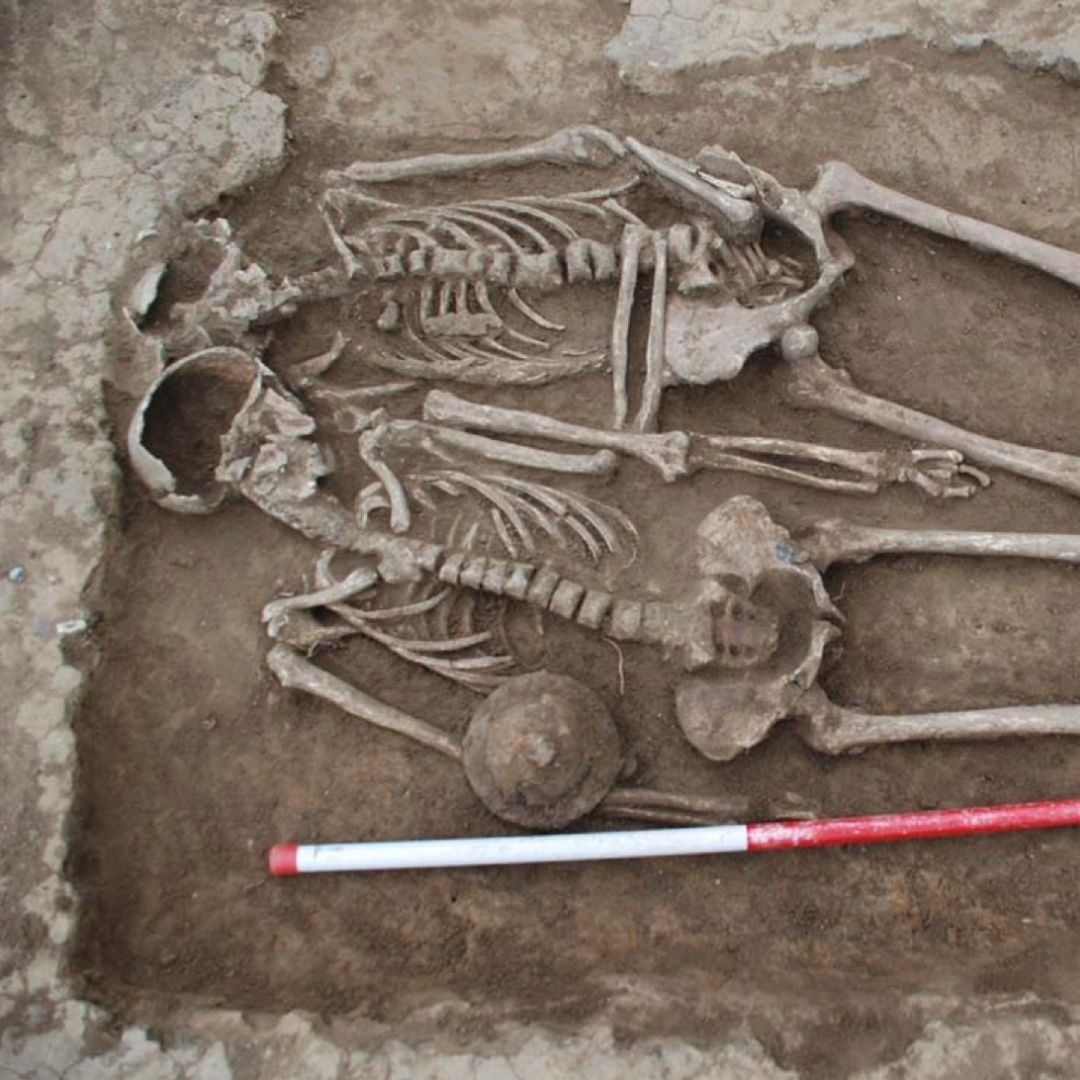This gas pipe happened to be laid straight through the skull of an Anglo Saxon woman, buried around 1,500 years ago.

The woman, discovered in 2014, was one of over 100 skeletons found in a 6th century Anglo Saxon cemetery in Oakington, Cambridgeshire.
The dig, which spanned multiple seasons from 2012-14, featured in Series 3 episode 1 of “Digging for Britain”.
Unintentionally, a yellow pipe, likely to be a gas line, was punched clean through an ancient burial.

This particular skeleton was buried very close to the modern road, which modern underground infrastructure supplying the village follows.
The yellow pipe was installed by the standard practice of directional drilling – this involves machinery tunnelling a long route for pipes, between small access trenches, minimising the disruption that would be associated with the more obvious “cut and fill” method for laying pipes.
Although geophysical sensing methods are used to scout for anomalies, hazards, or archaeological remains ahead of the drilling, these cannot reliably detect human bone.
It is overwhelmingly likely that the installer of the pipe was entirely unaware they had punched through the ancient burial.
The archaeologists noted during the 13-hour excavation how impressively the boring of the pipe had punched through cleanly, with minimal disruption to the burial, and missing the grave-goods by a matter of centimetres.

Respectful treatment of human remains is certainly desirable, and an increasingly important priority for archaeologists conducting excavations.
No archaeologist or engineer would want to see an ancient burial skewered in this way.
The skeleton was found with a small-long brooch on each shoulder, and an expensive large cruciform brooch face down, indicating she had been buried in a peplos dress and centrally pinned cloak.
She also had wrist-clasps representing a sleeved dress beneath the peplos, and had swags of glass and amber beads.
Archaeological excavations
Much of what we know about Oakington in the Anglo-Saxon period comes from excavations of an Anglo-Saxon burial ground that was located where the recreation ground is today.

The first graves were discovered in 1926, when four early Anglo-Saxon burials (including one with a spear, knife and shield) were uncovered in the field that had just been bought by Alan Bloom for his nursery garden.
A further 25 burials, and a single cremation, were discovered in 1994 during construction of the children’s playground and were excavated by Cambridgeshire Archaeological Field Unit.
Further work was carried out by Oxford Archaeology East in 2006–2007 in preparation for the building of Oakington Pavilion and multi-use games area (MUGA).
Test pits were dug in within the footprint of the new pavilion (Area A) and the (MUGA) (Area B), which lead to the recovery of about 600 sherds of pottery, over half of it Early to Middle Saxon, along with animal bone, metalwork and Neolithic flint.
A full excavation was then carried out on Area A, while Area B was left to be preserved ‘in situ’.

The excavations of Area A revealed seventeen burials from the early Anglo-Saxon period (all dated to the latter half of the sixth century), including both sexes and all age groups.
Eight of the burials contained multiple grave goods, including pairs of round brooches, strings of amber beads, bone combs, wrist clasps, and square-headed brooches.
Four of the burials contained a single item, either a knife or a single brooch, while five contained either no grave goods or a single large pot sherd.
Subsequently researchers from Oxford Archaeology East together the students from the University of Central Lancashire and Manchester Metropolitan University carried out a series of excavations between 2010 and 2014.
This resulted in the discovery of many more graves, bringing the total number of graves uncovered to more than 200 and establishing Oakington as a substantial 6th century (early Anglo-Saxon) cemetery.

Beyond the cemetery
The cemetery dates from the Early Anglo Saxon period (c. 420–660), and test pits dug at other sites around the village confirm the presence of a settlement contemporary with the cemetery.
Handmade Anglo-Saxon pottery was found over an area of some ten hectares, with Early Anglo-Saxon artefacts being concentrated in the area around where St Andrew’s Church stands today.
(The oldest parts of today’s church date from the Norman period, 1066–1150, several centuries later, and it is unlikely that there would have been a church on this site in Hoc’s time as the Anglo-Saxons were not Christians when they came to Britain).
One particularly interesting find was the site of an Early Anglo-Saxon posthouse, which was discovered in 2011 as two parallel lines of postholes (many containing pottery) in the garden of Oakington resident Nick Harrison.

This building would have dated from the 6th or 7th century and was thus contemporary with the cemetery.
Clues from the graves
What was life and death like in Early Anglo-Saxon Oakington? All too often the answer appears to have been difficult and short for the people whose graves were uncovered during the excavation of the cemetery.
About half of the burials were children aged about 12 or less, with about 30% being infants under six.
This is much higher than at other Anglo-Saxon burial sites, where infant burials have only rarely been found.
Nevertheless, a 30% infant mortality is consistent with that estimated for the Roman period and the Middle Ages, and the rarity of infant burials from the Anglo-Saxon period has been attributed to the fact that the infant graves were usually shallow which left them vulnerable to being destroyed by later ploughing.

At Oakington, however, part of the village corresponding to the location of the cemetery was only briefly ploughed, resulting in a much more representative preservation of burials.
Interestingly, many of the child burials included small pots as grave goods, or contained a single large pot sherd placed on the hip of the individual.
A few of the adult graves also contained pots, but these were larger vessels, as opposed to the cup-sized pots found in the infant graves.
The latter were evidently considered ‘child-sized’.
The bones of even the wealthier individuals showed evidence that the people were used to very heavy work, and examination of the teeth of individuals throughout the cemetery revealed low or absent levels of enamel – a condition most likely arising in childhood from severe diseases.

Because this affected all individuals examined, it is likely that it was not caused by a single famine, but rather by a continuous risk of food shortage affecting all members of the community.
Today, the finds are not currently displayed, they are held by the University of Central Lancashire.
If you enjoyed this blog post, please follow Exploring GB on Facebook for daily travel content and inspiration.
Don’t forget to check out our latest blog post below!
Thank you or visiting Exploring GB.
Smugglers Cott, Cornwall: Grade II Gem
Next
Next






